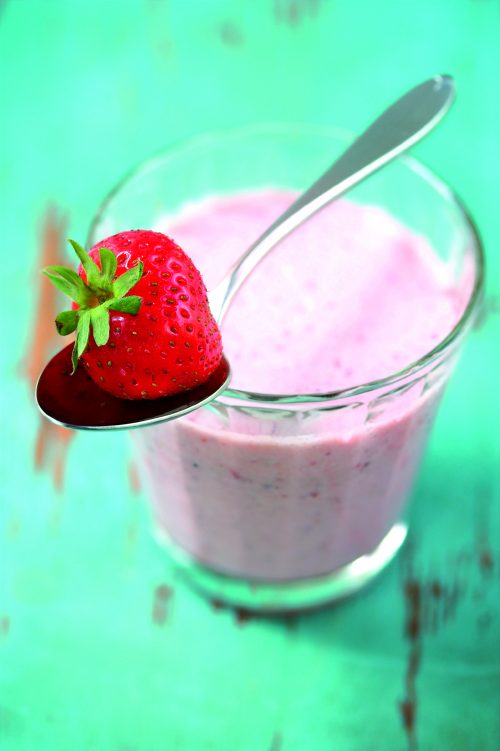
Advice on finding a yoghurt that suits you.
As a nutritionist it's always reassuring when you find you love a food that is really healthy, too. While I love chocolate, I struggle with the concept of consuming one or two squares of dark chocolate each day for its antioxidants. We all know it comes packaged with saturated fat; and besides, it's not physically possible to consume chocolate in such small morsels (is it?). If you're looking for a low-energy, portable snack that's full of goodness, a pottle of yoghurt has got to be high on the list. And because it's low GI it's a satisfying snack, keeping you fuller for longer.
In a typical New Zealand diet, dairy foods are an important source of calcium and B vitamins, especially riboflavin and vitamin B12. They also contain vitamins A and D as well as the minerals potassium, magnesium and zinc. When choosing dairy it's always advised to choose low-fat options, as dairy contains saturated fats, (the ones that raise our blood cholesterol), a precursor to heart disease.
Healthy bones
It's recommended we consume two or more serves of dairy foods every day – that includes milk, yoghurt, cheese and ice cream – and one of the reasons for that is they are our main source of calcium. The recommended dietary intake (RDI) for calcium for most adults is 1000mg, and for people over 70 it's 1300mg. Neither of those levels is easy to reach without more than two serves of dairy every day. (Other good sources include tinned sardines, thanks to the bones in them, tofu and fortified cereals.)
Healthy gut
Probiotic cultures in yoghurt can be beneficial to health by improving the microbial balance in your intestine. Although more research is needed, it seems that probiotics help our immune system, which may be particularly useful if you're run down or taking antibiotics. Not all cultures in yoghurt are probiotic, but the pack should tell you if they are. The most common probiotic cultures include Lactobacillus acidophilus, Bifidobacterium bifidus and Lactobacillus casei (the ABC cultures). Newer probiotic cultures are appearing but there's no evidence they're any more effective.
One of the issues surrounding probiotics is the amount of live probiotic cultures you actually receive. The Food Standards Code states that yoghurt must contain at least one million live bacteria per gram up to the best before date, but we don't actually know if we're getting that or not, or how much of what we are getting is the probiotic cultures. Survival of the cultures in large enough numbers to be beneficial is dependent on how many there are to start with, how old the yoghurt is and the conditions it's been stored in. Testing done last year by CHOICE magazine in Australia (subject to the same Food Standards Code) found many products did not comply.
Sugars
Yoghurt contains lactose, the main sugar in milk, although it has less lactose than milk. Any added fruit will contain natural sugars as well. If you prefer the tarter taste of unsweetened yoghurt, there are plenty to choose from.
Products calling themselves 'diet' are often sweetened with artificial sweeteners like aspartame, which is quite safe; other yoghurts are sweetened with added sugar or honey (itself around 80% sugars). As you can see on our table, some get up to around 25% sugars once the natural sugars and added sugars are added together. While I'd encourage you to go for a version without added sugar, if you need sweetening, so be it; low-fat yoghurt is still good food.
Often 'no added sugar' will be highlighted on the pack, as it's hard to tell unless you have good enough eyesight to read the ingredients list. But don't think 'no added sugar' is necessarily unsweetened; it may have another sweetener. And don't think low-fat yoghurt is necessarily low energy; it may have added sugar. If you stick to the guide of less than 600kJ for a pottle, you don't need to get too hung up on the sugars.
Vitamin K
Anlene yoghurt contains added vitamins and minerals shown to support bone health, including vitamin K. People taking Warfarin, a common blood-thinning drug, generally need to ensure they don't increase their vitamin K consumption. For this reason, the packaging contains a warning to these people; vitamin K is fine for the rest of us.
The bottom line: How to choose
Choosing yoghurt will depend on what you're using it for, and of course your taste preferences – fruit/plain/sweetened/unsweetened. If you're looking for a healthy, filling, low-energy snack, in a 150g pottle aim for:
- Less than 600kJ (less than 400kJ per 100g)
- Less than 2g fat (<1.3g per 100g)
- Higher in calcium; to help you achieve your daily requirement
- Preferably without added sugar; that's because many of us get more sugars in our overall diet than is good for us, which may or may not include you.
If you're looking for probiotic yoghurt, your 'best bet' is:
- Ensure the yoghurt contains probiotic bacteria – not all bacteria are probiotic
- Choose the most recently produced products (the bacteria can die off over time)
- Go for less sugar or preferably none (the bacteria can die off quicker with more sugar)
- Store according to the instructions for maximum potential benefit
- Greek-style yoghurts are delicious for desserts but they are usually much higher in fat compared to other yoghurts, at around 7-10%
- Our tasters were impressed with Cyclops low-fat Greek yoghurt, which was really thick and creamy (without any added thickeners – just natural yoghurt)
- Compare that to cream at 40% fat or reduced-fat cream still at 20% fat.
What's dairy food?
Dairy food is not yoghurt and is produced in a different way. Dairy food is made from milk and sugar with added flavouring and colour and usually using starch as a thickener. Because they tend to be sweeter than many (but not all) yoghurts and somewhat blander, along with popular flavours like chocolate and strawberry, they are often more appealing than yoghurts to younger children. Although I'd say yoghurt is better, as a dairy product they are a useful source of calcium and other nutrients in children's diets if yoghurt won't be eaten.
Make your own yoghurt
I went through a yoghurt-making phase in my youth, which proves how simple it is to make. My mother showed me how; by mixing a spoonful of bought yoghurt from the fridge with a bowlful of warm milk, it would ferment in the hot water cupboard overnight to become yoghurt. After that it was into the fridge and before it was finished the last few tablespoons were used to start the next batch. (Admittedly the berry flavour I preferred at that time got a bit diluted!)
These days an inexpensive yoghurt-maker makes the job easier, especially if you don't happen to have a hot water cupboard or the inclination to put your yoghurt in it! You can buy a wide variety of styles and flavours of yoghurt in sachets as your starter and all you have to do is add water. This is an economical option, which works out at around 50 cents or less for 150g.
Did you know?
- Yoghurt originates from Asia, where it's believed unintentional fermentation of milk in the hot climate probably led to its discovery as a food.
- The fermentation of the milk means most of the lactose is converted to lactic acid so it's much more easily digested by people with lactose intolerance, which is common amongst Asian people.
- Although the evidence is not totally consistent yet, it appears that low-fat dairy products, and the calcium in them, may promote
- weight-loss for overweight people.
www.healthyfood.com










